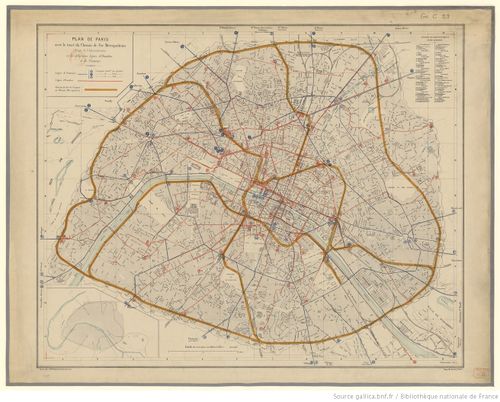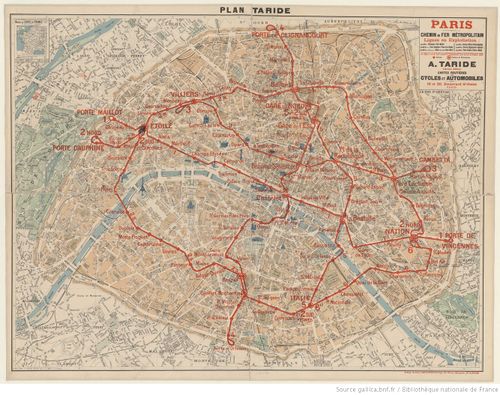Paris Metropolitan, an evolution: Difference between revisions
No edit summary |
|||
| Line 1: | Line 1: | ||
== | == Definition of the project == | ||
The group first selected a range of different maps showing the Paris Metropolitan at different years. In total, we collected a set of two maps of the planning of the metro, from the definition of the routes to the addition of stations, a first map from 1908 of the actual metro after its construction in 1990, a second map from 1915, with already visible impacts of the first war, and a third map from 1950, a more contemporain look at the metro as we know it today. Our first idea was to analyse these maps in order to understand the evolution of the Paris Metropolitan, how different areas of major cultural attractions evolved around or hand in hand with the metro stations and how it was impacted by catastrophic events such as wars. However, as the goal of the project is to produce a working interface within a short amount of time, we decided to reduce the work of extraction of data to one map, which is the first map from 1908. Based on this map, we thus intend to build a superposition of a current map from Paris and the metro network extracted from the old map. From this visual display, will be able to see the evolution of the Paris Metropolitan from 1908 until nowadays and important historical explanations will be linked to corresponding stations. The result should take the form of a website page that displays the interactive map. The users would have the possibility to display the different layers, namely the layer of the old map, its metro network, with stations and lines, and this on top of a current map of Paris. Popup windows on each stations would display specific historical information about the station, which would be linked to the sources. | |||
It is based on this prototype that the possibility to conduct similar data extractions on the other maps selected will be considered. | |||
== Main steps == | == Main steps == | ||
| Line 8: | Line 9: | ||
* Create a list of all stations from the first map of 1908 | * Create a list of all stations from the first map of 1908 | ||
* Determine the main cultural attractions around these stations | * Determine the main cultural attractions around these stations | ||
* Extract paths and stations from | * Georeference the map from 1908 | ||
* Create maps alignment with a contemporain map of Paris | |||
* Extract paths and stations from the map | |||
* Determine or extract coordinates of the different stations | * Determine or extract coordinates of the different stations | ||
* | * Create a Database with all the information gathered for each station from 1908 | ||
* Compare the first path and stations from 1908 with the actual built one | |||
* Compare the | |||
* Compare evolution of cultural attractions listed above, if new institutions appeared and if new metro lines were created due to them | * Compare evolution of cultural attractions listed above, if new institutions appeared and if new metro lines were created due to them | ||
* Create a website in order to display the maps in an interactive way | * Create a website in order to display the maps in an interactive way | ||
** pop up windows on specific points, such as stations with strong historical backgrounds | ** pop up windows on specific points, such as stations with strong historical backgrounds | ||
** an overlay of maps in order to better see the evolution from 1908 to | ** an overlay of maps in order to better see the evolution from 1908 to nowadays | ||
== | == Milestones == | ||
'''Week 9''': Georeference, alignment with contemporain map and extraction of the paths and stations | |||
'''Week 10''': Finish Database and analyse of the evolution of the Metropolitan Paris based on the information gathered | |||
'''Week 11''': Creation of the website to display the data | |||
'''Week 12''': Finalization of the project | |||
== Historical introduction to the map == | |||
== Detailed description of the extraction methods == | |||
In order to | |||
== Selected maps == | == Selected maps == | ||
Revision as of 16:49, 5 November 2018
Definition of the project
The group first selected a range of different maps showing the Paris Metropolitan at different years. In total, we collected a set of two maps of the planning of the metro, from the definition of the routes to the addition of stations, a first map from 1908 of the actual metro after its construction in 1990, a second map from 1915, with already visible impacts of the first war, and a third map from 1950, a more contemporain look at the metro as we know it today. Our first idea was to analyse these maps in order to understand the evolution of the Paris Metropolitan, how different areas of major cultural attractions evolved around or hand in hand with the metro stations and how it was impacted by catastrophic events such as wars. However, as the goal of the project is to produce a working interface within a short amount of time, we decided to reduce the work of extraction of data to one map, which is the first map from 1908. Based on this map, we thus intend to build a superposition of a current map from Paris and the metro network extracted from the old map. From this visual display, will be able to see the evolution of the Paris Metropolitan from 1908 until nowadays and important historical explanations will be linked to corresponding stations. The result should take the form of a website page that displays the interactive map. The users would have the possibility to display the different layers, namely the layer of the old map, its metro network, with stations and lines, and this on top of a current map of Paris. Popup windows on each stations would display specific historical information about the station, which would be linked to the sources. It is based on this prototype that the possibility to conduct similar data extractions on the other maps selected will be considered.
Main steps
- Download in high resolution the different maps
- Create a list of all stations from the first map of 1908
- Determine the main cultural attractions around these stations
- Georeference the map from 1908
- Create maps alignment with a contemporain map of Paris
- Extract paths and stations from the map
- Determine or extract coordinates of the different stations
- Create a Database with all the information gathered for each station from 1908
- Compare the first path and stations from 1908 with the actual built one
- Compare evolution of cultural attractions listed above, if new institutions appeared and if new metro lines were created due to them
- Create a website in order to display the maps in an interactive way
- pop up windows on specific points, such as stations with strong historical backgrounds
- an overlay of maps in order to better see the evolution from 1908 to nowadays
Milestones
Week 9: Georeference, alignment with contemporain map and extraction of the paths and stations Week 10: Finish Database and analyse of the evolution of the Metropolitan Paris based on the information gathered Week 11: Creation of the website to display the data Week 12: Finalization of the project
Historical introduction to the map
Detailed description of the extraction methods
In order to
Selected maps
The different maps selected for the project are the following:




